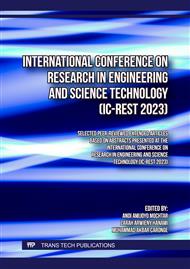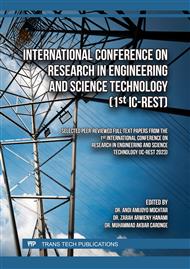[1]
M. Basumatary, A. Biswas, and R. D. Misra, "CFD analysis of an innovative combined lift and drag (CLD) based modified Savonius water turbine," Energy Convers. Manag., vol. 174, p.72–87, Oct. 2018.
DOI: 10.1016/j.enconman.2018.08.025
Google Scholar
[2]
N. R. Maldar, C. Y. Ng, and E. Oguz, "A review of the optimization studies for Savonius turbine considering hydrokinetic applications," Energy Convers. Manag., vol. 226, no. July, p.113495, 2020.
DOI: 10.1016/j.enconman.2020.113495
Google Scholar
[3]
A. Kumar and R. P. Saini, "Performance parameters of Savonius type hydrokinetic turbine - A Review," Renew. Sustain. Energy Rev., vol. 64, p.289–310, 2016.
DOI: 10.1016/j.rser.2016.06.005
Google Scholar
[4]
H. Alizadeh, M. H. Jahangir, and R. Ghasempour, "CFD-based improvement of Savonius type hydrokinetic turbine using optimized barrier at the low-speed flows," Ocean Eng., vol. 202, 2020.
DOI: 10.1016/j.oceaneng.2020.107178
Google Scholar
[5]
W. Tian, Z. Mao, and H. Ding, "Design, test and numerical simulation of a low-speed horizontal axis hydrokinetic turbine," Int. J. Nav. Archit. Ocean Eng., vol. 10, no. 6, p.782–793, 2018.
DOI: 10.1016/j.ijnaoe.2017.10.006
Google Scholar
[6]
F. Behrouzi, M. Nakisa, A. Maimun, Y. M. Ahmed, and A. Salem Souf-Aljen, "Performance investigation of self-adjusting blades turbine through experimental study," Energy Convers. Manag., vol. 181, no. November 2018, p.178–188, 2019.
DOI: 10.1016/j.enconman.2018.11.066
Google Scholar
[7]
S. Sharma and R. K. Sharma, "Performance improvement of Savonius rotor using multiple quarter blades – A CFD investigation," Energy Convers. Manag., vol. 127, p.43–54, 2016.
DOI: 10.1016/j.enconman.2016.08.087
Google Scholar
[8]
Y. Zhang, C. Kang, Y. Ji, and Q. Li, "Experimental and numerical investigation of flow patterns and performance of a modified Savonius hydrokinetic rotor," Renew. Energy, vol. 141, p.1067–1079, Oct. 2019.
DOI: 10.1016/j.renene.2019.04.071
Google Scholar
[9]
A. Kumar and R. P. Saini, Performance analysis of a single stage modified Savonius hydrokinetic turbine having twisted blades, vol. 113. Elsevier Ltd, 2017.
DOI: 10.1016/j.renene.2017.06.020
Google Scholar
[10]
N. H. Mahmoud, A. A. El-Haroun, E. Wahba, and M. H. Nasef, "An experimental study on improvement of Savonius rotor performance," Alexandria Eng. J., vol. 51, no. 1, p.19–25, 2012.
DOI: 10.1016/j.aej.2012.07.003
Google Scholar
[11]
P. K. Talukdar, V. Kulkarni, and U. K. Saha, "Performance estimation of Savonius wind and Savonius hydrokinetic turbines under identical power input," J. Renew. Sustain. Energy, vol. 10, no. 6, 2018.
DOI: 10.1063/1.5054075
Google Scholar
[12]
P. K. Talukdar, A. Sardar, V. Kulkarni, and U. K. Saha, "Parametric analysis of model Savonius hydrokinetic turbines through experimental and computational investigations," Energy Convers. Manag., vol. 158, no. October 2017, p.36–49, 2018.
DOI: 10.1016/j.enconman.2017.12.011
Google Scholar
[13]
E. Kerikous and D. Thévenin, "Optimal shape of thick blades for a hydraulic Savonius turbine," Renew. Energy, vol. 134, p.629–638, 2019.
DOI: 10.1016/j.renene.2018.11.037
Google Scholar
[14]
M. J. Khan, G. Bhuyan, M. T. Iqbal, and J. E. Quaicoe, "Hydrokinetic energy conversion systems and assessment of horizontal and vertical axis turbines for river and tidal applications: A technology status review," Appl. Energy, vol. 86, no. 10, p.1823–1835, 2009.
DOI: 10.1016/j.apenergy.2009.02.017
Google Scholar
[15]
G. Kailash, TI. Eldho TI, SV. Prabhu, Performance Study of Modified Savonius Water Turbine with Two Deflector Plates, International Journal of Rotating Machinery 12 (2012).
DOI: 10.1155/2012/679247
Google Scholar
[16]
M. Ahmadi-Baloutaki, R. Carriveau, and D. S. K. Ting, "Effect of free-stream turbulence on flow characteristics over a transversely-grooved surface," Exp. Therm. Fluid Sci., vol. 51, p.56–70, 2013.
DOI: 10.1016/j.expthermflusci.2013.07.001
Google Scholar
[17]
E. R. Gowree, C. Jagadeesh, and C. J. Atkin, "Skin friction drag reduction over staggered three dimensional cavities," Aerosp. Sci. Technol., vol. 84, p.520–529, 2019.
DOI: 10.1016/j.ast.2018.11.001
Google Scholar



